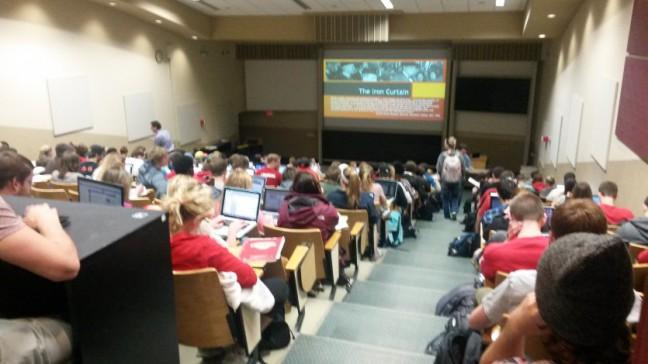We’ve all taken that class that seemed impossible to pass, classes where professors idly accept the difficulty of the course with little adjustments in way of easing the workload. It is in these classes that the concept of grading curves come into play, in an attempt to mask your failing grade as one of passing. However, most grading curves result in an increased in-class competition that seems more like a lottery of class placement than any kind of indication of knowledge.
Grading on a bell curve works by pitting everybody’s test scores against each other, creating a relative scale to assess the best and the worst of the class. Depending on the class’s spread, grades can be artificially skewed higher or lower, which changes the dynamics of the classroom.
In many cases, tests ask questions never covered in class, and only the most dedicated students are able to obtain high grades. Rather than restructuring tests and lecture, teachers set up grading curves. No longer are hours of rigorous study reflected in test scores that are based on absolute value. Rather, it plays out more like a twisted survival story. You wake up in the middle of a classroom of strangers that you are required to compete against in hopes of coming out on top. Now you must account for these hidden variables as you fight for the limited grades.
Teachers love to point to the difference of difficulty of tests between classes as the main factor. However, this proves to be only a small one, as the teacher is responsible for the difficulty of their tests and is a variable that can be changed. The other and larger factor is the demographic of the class you were placed in, something no one has any knowledge about prior to you signing up for it. You could get a class filled with shining students who dedicate their lives to academia, or a class filled with bumbling idiots; it’s the luck of the draw.
This is where the idea of a survival lottery comes in. You have no idea of the ability of your competitors when signing up for a class, yet you are required to compete against them. While competition of the real world drives success in school, they always seemed to be two separate worlds. Yet with grading curves your attention is divided between teacher and competitive classmates, as classroom dynamics change.
This changes the concept of a passing grade in class. No longer are grades determinate of your ability, but they are artificially limited by the very teachers who made the class difficult in the first place. On the other end of the spectrum, a student who put forth half the effort as those students fighting for A’s gets rewarded with a facade of a passing grade and is commended for “trying.” This pinches the top of the class and pulls up the bottom.
It is here where blame should be placed. We learn from the teacher and read from the corresponding material. We are then tested on our knowledge of the specific subject and its application, receiving a score based on how many points we got correct. Nowhere in this medieval process does it account for the expectance of a better grade than we deserve. We shouldn’t account for unforeseen competition that can either drive up or down the class average, rather only on our pure substantiated knowledge should we be assessed. If you and 50 other people can’t receive one A or B, it is good evidence that the class itself is either too difficult or inaccessible, and no curve should artificially raise your grade because “you tried.”
This doesn’t mean all teachers want you to fight for you life. University of Wisconsin sociology professor Joseph Conti claims that grading curves create unneeded competition in-class, and prefers to allow students to win points in absolute value to determine grades. This shows that even within teaching circles, there is healthy dispute between the alteration of classroom dynamics and grade distribution and how they affect students.
As psychology professor Marty Covington writes in his book, Making the Grade, A Self-Worth Perspective on Motivation and School Reform, he writes, “When conditions of scarcity [of A and B grades] prevail, failure is more likely to be interpreted [by students] as a matter of personal inadequacy, whereas success was often seen as the result of chance or good fortune.” Covington outlines the real issue of in-class competition, as not only grades but feelings of self-worth are now facades. While competitive motivation is stapled in a “real world” setting, this form of in-class competition is ambiguous and works against the students.
In light of its use, the bell curve can be used specifically to achieve a good class average, instead of the grizzly competition mentioned earlier. In this case, the spread of percentage might lie heavily in the B and C range, giving very little percentage in the D, F and A range. While it can artificially boost the grades of worthy individuals, it still sidesteps the heart of the problem by marginalizing students into grade positions that they didn’t necessarily deserve. The scene has now shifted from the grizzly survival competition to the teacher with a straw hat and whip, herding the student cattle into nice and lush “class average” pastures in order to artificially make his student cattle look nicer.
While many grading curves have proved beneficial for difficult classes, it misses the point. We shouldn’t give up the accessibility of good grades for the sake of the class to remain difficult yet manageable. If a grading curve is needed, it is a sure sign that the class as a whole needs to be re-evaluated in light of its difficulty, instead of limiting grades and creating a die-hard survival contest for those who want an “A.”
Alex Mohney (alexmohney@hotmail.com


